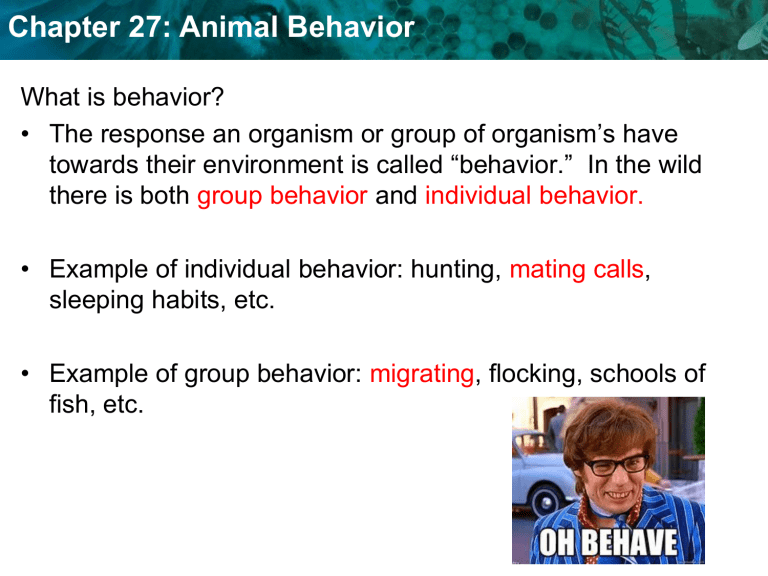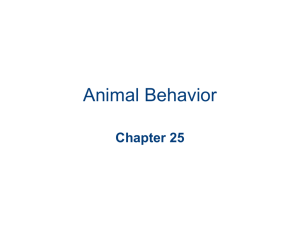Chapter 27: Animal Behavior

Chapter 27: Animal Behavior
What is behavior?
• The response an organism or group of organism’s have towards their environment is called “behavior.” In the wild there is both group behavior and individual behavior.
• Example of individual behavior: hunting, mating calls , sleeping habits, etc.
• Example of group behavior: migrating , flocking, schools of fish, etc.
Chapter 27: Animal Behavior
Behavior lets organisms respond rapidly and adaptively to their environment. Usually in a beneficial way.
Examples?
Plant bends toward light
Pufferfish inflates when threatened
Cat comes when you use a can opener
Toad releases poison when grabbed
Chapter 27: Animal Behavior
Why is behavior important and how does it work?
• Detecting and responding to stimuli is key to an individual’s survival. There are two types of stimuli:
• Internal stimuli tell an animal what is occurring in its own body.
– hunger
– thirst
– pain
Chapter 27: Animal Behavior
• External stimuli give an animal information about its surroundings.
– sound
– sight
– changes in day length or temperature
Chapter 27: Animal Behavior
• Specialized cells that are sensitive to stimuli detect sensory information.
– information is transferred to the nervous system
– nervous system may activate other systems in response
• Animal behaviors help to maintain homeostasis .
Chapter 27: Animal Behavior
Turn to your neighbor: Review! What are the types of cells found within the nervous system?
Chapter 27: Animal Behavior
• There are two examples of movement-related behaviors:
– Kinesis is an increase in random movement.
Example: Pill bugs increase activity as they dry out to find moist areas
– Taxis is movement in a particular direction either toward or away from a stimuli
–Example: plants growing toward light, deer running away from rustling in the brush
Chapter 27: Animal Behavior
Why do particular behaviors occur? Internal and external stimuli usually interact to trigger specific behaviors .
• Most behaviors are a response to both internal and external stimuli
– Combination, not just one stimuli
• External stimuli may trigger internal stimuli.
• Green anole reproductive behavior is triggered by internal and external stimuli.
– External: males become aggressive and court females
– Internal: females release hormones that make females receptive
Chapter 27: Animal Behavior
Turn to your neighbor: How could internal and external stimuli cause you to wake up in the morning?
Chapter 27: Animal Behavior
Some behaviors occur in cycles.
• A circadian rhythm is the daily cycle of activity.
– occurs over a 24-hour period
– run by a biological clock
Chapter 27: Animal Behavior
• Turn to your neighbor: Turn to your neighbor: When people travel, they often complain that the jet-lag is messing with their “Circadian Rhythm.” Explain what they mean.
Chapter 27: Animal Behavior
• Behaviors may occur daily, monthly, seasonally, or annually.
– During hibernation, an animal enters a seasonal dormant state.
Chapter 27: Animal Behavior
• Turn to your neighbor: What kind of stimuli might trigger hibernation?
Chapter 27: Animal Behavior
• Behaviors may occur daily, monthly, seasonally, or annually.
– During hibernation, an animal enters a seasonal dormant state.
– During migration, animals move seasonally from one portion of their range to another.
Chapter 27: Animal Behavior
• Turn to your neighbor: Is migration an individual or group behavior?
Chapter 27: Animal Behavior
Nature vs. Nurture
Both genes and environment affect an animal’s behavior.
Chapter 27: Animal Behavior
What is an “instinct” ?
• An instinct is a complex inborn behavior.
• Instinctive behaviors share several characteristics.
– innate, or performed correctly the first time
– relatively inflexible
– Why would instincts be necessary?
– Baby Swimming Reflex
Chapter 27: Animal Behavior
Many behaviors have both innate and learned components.
• Learning takes many forms.
• Imprinting is an example of learned behavior.
• Imprinting: when an organism copies behavior they observe, usually shortly after their birth
• Example: Graylag geese imprint 12 hours after hatching: they learn to follow around their parents . Scientists who work with these geese have to be careful not to let hatchlings imprint on them instead of their geese parents.
Chapter 27: Animal Behavior
Turn to your neighbor: Why might this person be wearing a goose costume?
Chapter 27: Animal Behavior
• Imitation: When organisms copy behaviors they see displayed by others
– young male songbirds learn songs by listening to adult males
– Children learning to talk
– snow monkeys and potato-washing behavior…younger teaches older
Chapter 27: Animal Behavior
Conditioning
• The behavior of an organism is not constant: it can change depending on the organism’s surroundings . Conditioning describes the way an organism’s behavior changes based on whether the behavior results in a positive or negative outcome. There are two types of conditioning:
Chapter 27: Animal Behavior
– Classical conditioning: previously neutral stimulus associated with behavior triggered by different stimulus
– Ivan Pavlov and salivating dog
Chapter 27: Animal Behavior
– Operant conditioning: behavior increased or decreased by positive or negative reinforcement
– B.F. Skinner and “Skinner boxes”
Chapter 27: Animal Behavior
• Turn to your neighbor: Explain how bells are used to condition student behavior.
Chapter 27: Animal Behavior
All behaviors have benefits and costs
• The benefits of a behavior are increased survivorship (# of individuals that survive from one year to the next) and reproduction rates.
– both increase an individual’s fitness; favored by natural selection
– both have costs
Chapter 27: Animal Behavior
• Behavioral costs can be divided into three categories.
– energy costs: energy not available for other tasks
– opportunity costs: time spent cannot be used on another task
– risk costs: need food but risk getting eaten
Some behaviors seem harmful but are beneficial
Chapter 27: Animal Behavior
• Turn to your neighbor: If a song-bird spends an entire day trying to attract a mate, what is one opportunity-cost of this behavior?
Chapter 27: Animal Behavior
Animals perform behaviors whose benefits outweigh their costs.
• Behaviors evolve only if they improve fitness.
• Territoriality refers to the control of a specific area.
Chapter 27: Animal Behavior
Living in groups also has benefits and costs.
• Social behaviors evolve when the benefits of group living outweigh its costs.
– benefits: improved foraging, reproductive assistance, reduced predation
– costs: increased visibility, competition, disease contraction
• Group living requires learning social structure and membership.
Chapter 27: Animal Behavior
Are humans more intelligent than other animals?
• Insight is the ability to solve a problem mentally without repeated trial and error .
– observed in primates, dolphins, and corvids
– chimpanzee retrieving hanging bananas
Chapter 27: Animal Behavior
Cognitive ability may provide an adaptive advantage for living in social groups.
• Intelligence in animals seems to be correlated with two characteristics.
1. relatively large brains for their body size
2. live in complex social groups
Chapter 27: Animal Behavior
• Cultural behavior spreads through a population by learning, not by selection.
– taught to one generation by another
– aided by living in close proximity




